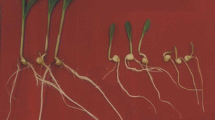Abstract.
The uptake of water and of the fluorescent apoplastic dye PTS (trisodium 3-hydroxy-5,8,10-pyrenetrisulfonate) by root systems of young maize (Zea mays L.) seedlings (age: 11–21 d) has been studied with plants which either developed an exodermis (Casparian band in the hypodermis) or were lacking it. Steady-state techniques were used to measure water uptake across excised roots. Either hydrostatic or osmotic pressure gradients were applied to induce water flows. Roots without an exodermis were obtained from plants grown in hydroponic culture. Roots which developed an exodermis were obtained using an aeroponic (=mist) cultivation method. When the osmotic concentration of the medium was varied, the hydraulic conductivity of the root (Lp r in m3 · m−2 · MPa−1 · s−1) depended on the osmotic pressure gradient applied between root xylem and medium. Increasing the gradient (i.e. decreasing the osmotic concentration of the medium; range: zero to 40 mM of mannitol), increased the osmotic Lp r. In the presence of hydrostatic pressure gradients applied by a pressure chamber, root Lp r was constant over the entire range of pressures (0–0.4 MPa). The presence of an exodermis reduced root Lp r in hydrostatic experiments by a factor of 3.6. When the osmotic pressure of the medium was low (i.e. in the presence of a strong osmotic gradient between xylem sap and medium), the presence of an exodermis caused the same reduction of root Lp r in osmotic experiments as in hydrostatic ones. However, when the osmotic concentration of the medium was increased (i.e. the presence of low gradients of osmotic pressure), no marked effect of growth conditions on osmotic root Lp r was found. Under these conditions, the absolute value of osmotic root Lp r was lower by factors of 22 (hydroponic culture) and 9.7 (aeroponic culture) than in the corresponding experiments at low osmotic concentration. Apoplastic flow of PTS was low. In hydrostatic experiments, xylem exudate contained only 0.3% of the PTS concentration of the bathing medium. In the presence of osmotic pressure gradients, the apoplastic flow of PTS was further reduced by one order of magnitude. In both types of experiments, the development of an exodermis did not affect PTS flow. In osmotic experiments, the effect of the absolute value of the driving force cannot be explained in terms of a simple dilution effect (Fiscus model). The results indicate that the radial apoplastic flows of water and PTS across the root were affected differently by apoplastic barriers (Casparian bands) in the exodermis. It is concluded that, unlike water, the apoplastic flow of PTS is rate-limited at the endodermis rather than at the exodermis. The use of PTS as a tracer for apoplastic water should be abandoned.
Similar content being viewed by others
Author information
Authors and Affiliations
Additional information
Received: 9 October 1997 / Accepted: 5 February 1998
Rights and permissions
About this article
Cite this article
Zimmermann, H., Steudle, E. Apoplastic transport across young maize roots: effect of the exodermis. Planta 206, 7–19 (1998). https://doi.org/10.1007/s004250050368
Issue Date:
DOI: https://doi.org/10.1007/s004250050368



